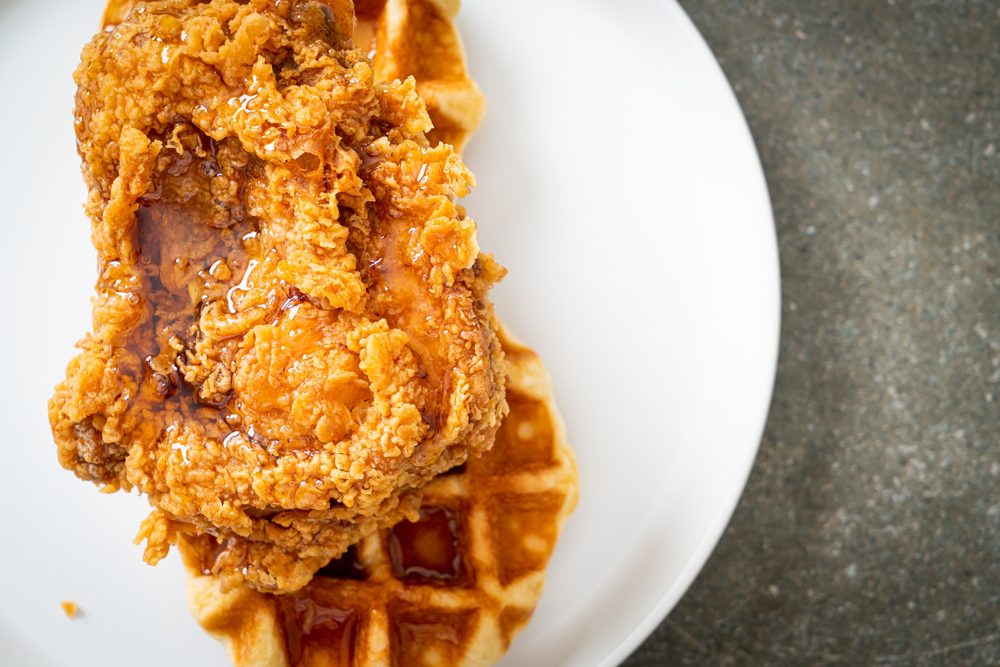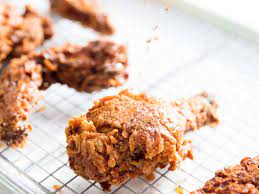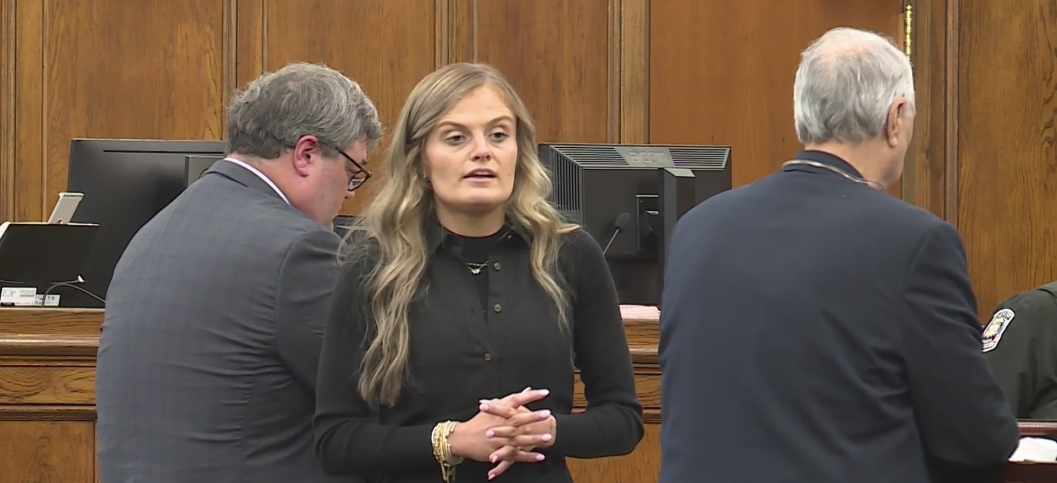
This past Thursday America celebrated “National Fried Chicken Day.” Proof that everyone and everything gets its fifteen minutes of fame, I suppose. In the Deep South, any day can be a fried chicken day. From grandma’s skillet fried chicken to the gas station variety, we love our battered bird.
But today’s dish, chicken and waffles, likely did not originate in the South. Some trace the dish back to the Pennsylvania Dutch, where recipes for hotcakes and chicken emerged as early as the 1700s. Most, however, point to a dish served in Harlem at the Wells Supper Club in the 1930s. Hungry jazz musicians who had been playing all night were greated with a breakfast staple fortified with some fried chicken.
Whatever the origin, the sweet and savory combination has gained new popularity among foodies in the last decade. Here’s a guide to the chicken and waffles, complete with a tabasco “syrup” and mimosas for good measure.
Brining the Bird
This recipe calls for boneless, skinless thighs. You could use boneless breasts if you prefer the distinct blandness that comes with the cut. This same recipe can be applied to fry bone-in, skin-on yardbird.
Any good fried chicken starts with a good brine. There are all manner of brines out there. Sweet tea brines. Pickle brines. Water brines. We will start with a kicked up buttermilk brine.
But first, a word on the point of brining. Brining, at its most basic, is submerging meat in a salty liquid. The goal, particularly with poultry that can dry out quickly, is to maintain moisture. Brining does not add moisture, per se, but it results in a break down of certain proteins in the meat. Left unbroken, these proteins tighten and act to secrete moisture during cooking. Broken, they don’t release all the marvelous juice of the bird. It’s science!
Brine recipe:
- 2 Cups Buttermilk
- 1/2 Cup Hot Sauce
- 2 Tablespoon Kosher Salt
- 1 Tabespoon Garlic Powder
- 1 Tablespoon Dried Oregano
- 1 Tablespoon Paprika
- 1 Tablespoon Sugar
- 1/2 Teaspoon Cayenne
- Two Eggs
- Couple Sprigs of Fresh Rosemary
- Couple Sprigs of Fresh Thyme
- Couple Sprigs of Fresh Sage
Cooking with hot sauce is like cooking with wine. Use what you like to drink. I use Louisiana. Whisk the eggs. Combine all the ingredients and stir thoroughly. Pour over your chicken thighs in a bowl. Cover said bowl with saran wrap and put it in the fridge for 2-4 hours.
Note: If you use this to fry bone-in chicken, let it steep in the brine over night.
Battering the Bird
First, let’s talk your flour mix and how to season. Your flour mix is going to be more than all purpose flour. Basically, you want one part corn starch to every three parts all purpose flour. Corn starch will increase the crispiness of the fry. It also undergoes a chemical reaction when it hits hot shortening or lard that helps to lock in moisture.
Batter recipe:
- 1 1/2 Cups of All Purpose Flour
- 1/2 Cup of Cornstarch
- 1 Teaspoon Baking Powder
- 3 Teaspoons Salt
- 1 Tablespoon Garlic Powder
- 1 Tablespoon Onion Powder
- 1 Tablespoon Dried Oregano
- 1 Tablespoon Paprika
- 1 Tablespoon Finely Ground Black Pepper
- 1/2 Teaspoon Cayenne Pepper
Combine all the ingredients and make sure they are evenly mixed. Everyone wants “craggy” chicken. There are two ways to get that rugged exterior.

One way is by dredging the chicken twice. This looks like taking the chicken out of the brine, dredging it in your flour mixture, putting the dredged chicken back in the brine and then dredging it a second time in the flour mixture. It produces a very thick crust. Too thick for my taste with a cut as thin as a boneless, skinless chicken thigh.
The second way is to produce some clumps in your flour mixture before you dredge. This is easily done by dribbling some of your brine into your flour and mixing it up before dredging your first piece of chicken. This is how I do it, but you do you.
Frying the Bird
You’ve brined it. You’ve battered it. Let’s fry it. There are as many tips, tricks and methods to frying out there as there are brines and batters. I fry chicken in vegetable shortening. I’d probably fry it in lard if I had some loafing around. In any regard, shortening yields a better result than vegetable oil.
This recipe uses a cast iron skillet for frying. In other words, it is not “deep frying.” Put two cups of vegetable shortening in your cast iron skillet. Heat it until the temperature of the oil is between 325-350 degrees. Add your chicken slowly. Don’t overcrowd the skillet. The chicken needs to social distance. Fry it 4 minutes (or so) on one side and then flip it over and repeat. (I eyeball this based on the crust formation. I don’t really time it).
When done frying, place the chicken on a wire rack over a baking pan. This will prevent it from steaming and getting soggy.
Note: Obviously, if you were cooking bone-in chicken it would take longer to fry. For that reason, you want your shortening around 325 degrees if frying bone-in. If you find that your crust is getting too dark before the chicken is cooked, you can always fry until the crust is to your likely and then finish it in the oven. Just use a wire rack over a baking pan.
Waffles
You will either need a waffle iron or be willing to use storebought waffles. Waffle irons aren’t very expensive or hard to come by. Here’s a basic waffle recipe:
- 3 cups all-purpose flour
- 1 Tablespoon, Plus 3/4 Teaspoon Baking Powder
- 1/2 Teaspoon Kosher Salt
- 2 Large Eggs
- 2 Cups Whole Milk
- 1 Stick Unsalted Butter, Melted
- 1/4 Cup Sugar
- 1 Teaspoon Vanilla Extract
Whisk flour, baking powder, and salt in a bowl. Separate yolks from eggs. Set aside egg whites. Whisk the egg yolks. Add whole milk, melted butter, sugar, and vanilla extract to bowl with egg yolks and whisk until smooth. Whisking constantly, gradually add your flour mixture, whisking until incorporated. Lightly whisk reserved egg whites until foamy, then fold into batter.
Heat your waffle iron. Lightly coat it with nonstick vegetable oil spray. Pour ½ cup batter onto iron and cook until waffles are golden brown and cooked, about 4 minutes per waffle.
Or…open a box of Eggos.
Tobasco “Syrup”
Okay, it’s not really syrup. It’s honey infused with tobasco and some other ingredients. It can be made with maple syrup instead of honey, but I don’t think it’s as good. Here’s what you need:
- 1 Cup of Honey (or Maple Syrup)
- 1 Tablespoon of Tobasco (I know I said to use whatever you like, and you can, but I think the unique flavor tobasco works well here)
- 2 Tablespoons of Butter
- 1/4 Teaspoon of Salt
- 1 Sprig of Rosemary
- Red Pepper Flakes (If you want more heat)
- 1/2 Teaspoon of Apple Cider Vinegar

This is simple. Heat your honey over low heat, with rosemary sprig, until the honey “loosens up,” or “thins out.” After a few minutes, add your Tobasco, butter, salt and red pepper flakes (if you want more heat). Turn up heat and bring to a quick boil. Turn off heat. Once the mixture has cooled for a few minutes, add a splash of apple cider vinegar.
If you don’t want to go through this step, there is a product called “Mike’s Hot Honey” that is pretty darn good.
Now, put your chicken on your waffle, and your “syrup” on your chicken and enjoy.
Mimosas
Finally, an easy breakfast/brunch drink. Mimosas are just champagne and citrus juice. Most people use orange juice, though you can make a mimosa with pineapple juice or grapefruit juice. They’re equally tasty. The “recipe” is simple. It’s just one part champagne. One part citrus juice. Don’t buy good champagne for this, unless you are Daddy Warbucks. Cava or your favorite sparkling wine works fine in place of champagne, too.
Cheers!











